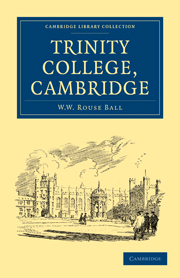Book contents
- Frontmatter
- PREFACE
- Contents
- LIST OF ILLUSTRATIONS
- CHAPTER I THE COURTS AND BUILDINGS
- CHAPTER II SOME INTERIORS
- CHAPTER III KING'S HALL AND MICHAEL-HOUSE, 1316–1546
- CHAPTER IV FOUNDATION AND GROWTH OF TRINITY COLLEGE, I546–1615
- CHAPTER V THE COLLEGE FROM 1615 TO 1820
- CHAPTER VI THE NINETEENTH CENTURY RENAISSANCE
- INDEX
CHAPTER VI - THE NINETEENTH CENTURY RENAISSANCE
Published online by Cambridge University Press: 05 August 2011
- Frontmatter
- PREFACE
- Contents
- LIST OF ILLUSTRATIONS
- CHAPTER I THE COURTS AND BUILDINGS
- CHAPTER II SOME INTERIORS
- CHAPTER III KING'S HALL AND MICHAEL-HOUSE, 1316–1546
- CHAPTER IV FOUNDATION AND GROWTH OF TRINITY COLLEGE, I546–1615
- CHAPTER V THE COLLEGE FROM 1615 TO 1820
- CHAPTER VI THE NINETEENTH CENTURY RENAISSANCE
- INDEX
Summary
MANSEL died in 1820, and was succeeded in the mastership by Christopher Wordsworth, the brother of the poet. Wordsworth was not a strong man, nor always judicious, but he had the good of the Society at heart, and was ever willing to spend himself in its service. The building of the New Court was undertaken on his initiative. The time of his accession was one of considerable intellectual activity, and opens a new era in the history of the College.
At this time, conspicuous among the Fellows of Trinity were A. Sedgwick, the geologist; G. Peacock, the mathematician; J. Scholfield, Julius C. Hare, and C. Thirlwall, the well-known scholars; and G. B. Airy, the astronomer. It would be difficult to exaggerate their influence on the intellectual life of the College and University. The undergraduate society a few years later numbered a group of men of exceptional power, notably R. C. Trench, afterwards Archbishop of Dublin, W. M. Thackeray, Edward Fitzgerald, Monckton Milnes (Lord Houghton), James Spedding, the biographer of Bacon, A. H. Hallam, A. W. Kinglake, the historian, Alfred, Charles, and Frederick Tennyson, and W. H. Thompson.
- Type
- Chapter
- Information
- Trinity College, Cambridge , pp. 89 - 102Publisher: Cambridge University PressPrint publication year: 2010First published in: 1906



